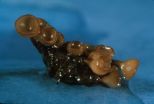Lifestyle intervention for overweight patients with diabetes provides long-term benefits
2010-09-28
(Press-News.org) An intensive lifestyle intervention appears to help individuals with type 2 diabetes lose weight and keep it off, along with improving fitness, control of blood glucose levels and risk factors for cardiovascular disease, according to a report in the September 27 issue of Archives of Internal Medicine, one of the JAMA/Archives journals.
Improving blood glucose control and cardiovascular risk factors in patients with type 2 diabetes is critical in preventing long-term complications of the disease, according to background information in the article. Emphasis has been placed on screening and pharmacologic management of these parameters. "Lifestyle-based weight loss interventions are also recommended to improve glycemic control and risk factors, but the evidence supporting the efficacy of lifestyle approaches is limited to short-term studies of typically less than one year," the authors write.
The Look AHEAD (Action for Health in Diabetes) Research Group conducted a multicenter randomized clinical trial comparing the effects of an intensive lifestyle intervention to diabetes support and education among 5,145 overweight or obese individuals (average age 58.7) with type 2 diabetes. Of these, 2,570 were assigned to the lifestyle intervention, a combination of diet modification and physical activity designed to induce a 7 percent weight loss in the first year and maintain it in subsequent years. Participants were seen and contacted by phone at least monthly for all four years. The 2,575 individuals assigned to the diabetes support and education group were invited to three group sessions each year focusing on diet, physical activity and social support.
On average, across the four-year period, individuals in the lifestyle intervention group lost a significantly larger percentage of their weight than did those in the diabetes support group (6.2 percent vs. 0.9 percent). They also experienced greater improvements in fitness, hemoglobin A1c level (a measure of blood glucose), blood pressure and levels of high-density lipoprotein (HDL, or "good" cholesterol). Individuals in the diabetes support group, on the other hand, experienced greater reductions in low-density lipoprotein (LDL, or "bad") cholesterol, owing to greater use of cholesterol-lowering medications in this group.
At the end of four years, the lifestyle intervention group maintained greater improvements in weight, fitness, hemoglobin A1c levels, systolic (top number) blood pressure and HDL levels. "Although the differences between the two groups were greatest initially and decreased over time for several measures, the differences between the groups averaged across the four years were substantial and indicate that the intensive lifestyle intervention group spent a considerable time at lower cardiovascular disease risk," the authors write.
"The critical question is whether the differences between groups in risk factors will translate into differences in the development of cardiovascular disease," they continue. "These results will not be available for several additional years. However, effects of the magnitude that we observed for fitness, HDL-C and hemoglobin A1c levels and blood pressure have been associated with decreased cardiovascular events and mortality in previous medication trials and observational studies. Moreover, there may be long-term beneficial effects from the four-year period in which intensive lifestyle intervention participants have been exposed to lower cardiovascular disease risk factors, as seen in other clinical trials."
###
(Arch Intern Med. 2010;170[17]:1566-1575. Available pre-embargo to the media at www.jamamedia.org.)
Editor's Note: Please see the article for additional information, including other authors, author contributions and affiliations, financial disclosures, funding and support, etc.
END
ELSE PRESS RELEASES FROM THIS DATE:
2010-09-28
While both black patients and white patients appear to benefit from end of life discussions with their physician, black patients are less likely to experience end-of-life care that accurately reflects their preferences, according to a report in the September 27 issue of Archives of Internal Medicine, one of the JAMA/Archives journals.
"Although black patients are also more likely than white patients to desire life-prolonging measures, receipt of life-prolonging care at the end of life is associated with greater distress and with poorer quality of life," the authors write ...
2010-09-28
Home-based exercises followed by voluntary home training seem to be associated with long-term effects on balance and gait (manner of walking), and may help protect high-risk, elderly women from hip fractures, according to a report in the September 27 issue of Archives of Internal Medicine, one of the JAMA/Archives journals.
"Falls are responsible for at least 90 percent of all hip fractures," the authors write as background in the article. "Hip fractures place the greatest demands on resources and have the greatest effect on patients because they are associated with high ...
2010-09-28
Use of pine bark extract, at a dose of 200 milligrams per day, appears safe but did not improve risk factors for heart disease, according to a report in the September 27 issue of Archives of Internal Medicine, one of the JAMA/Archives journals.
"Although traditional strategies such as prescription medications, dietary changes and physical activity have proven benefits for reducing cardiovascular disease risk, a substantial population seeks alternative therapies, including various dietary supplements, to lower cardiovascular disease risk," the authors write as background ...
2010-09-28
ANN ARBOR, Mich.---The more complex a plant or animal, the more difficulty it should have adapting to changes in the environment. That's been a maxim of evolutionary theory since biologist Ronald Fisher put forth the idea in 1930.
But if that tenet is true, how do you explain all the well-adapted, complex organisms---from orchids to bower birds to humans---in this world?
This "cost of complexity" conundrum puzzles biologists and offers ammunition to proponents of intelligent design, who hold that such intricacy could arise only through the efforts of a divine designer, ...
2010-09-28
Software downloaded during a routine office visit cuts the risk of inappropriate shocks by 50 percent for patients with implantable cardioverter defibrillators (ICD), according to research reported in Circulation: Journal of the American Heart Association.
"Hundreds of patients have been saved from unnecessary shocks by software that is safe and can be painlessly downloaded in one minute during a standard defibrillator check," said Charles D. Swerdlow, M.D., lead author of the study and a cardiac electrophysiologist at the Cedars Sinai Heart Institute in Los Angeles and ...
2010-09-28
Using data from more than 270,000 hospital stroke admissions, scientists have identified how to predict which patients are at greatest risk of dying in the hospital after stroke. Before their study, well validated models to predict in-hospital death risk after stroke were lacking, the researchers reported in Circulation: Journal of the American Heart Association.
"A mortality risk assessment tool for hospitalized stroke patients is important to clinicians, hospitals and patients," said Eric E. Smith, M.D., M.P.H., lead author of the study and assistant professor of neurology ...
2010-09-28
VIDEO:
In a few tenths of a second, Sclerotinia expels hundreds of thousands of spores in a plume that can rise 20 cm, much higher than any single spore by itself....
Click here for more information.
Long before geese started flying in chevron formation or cyclists learned the value of drafting, fungi discovered an aerodynamic way to reduce drag on their spores so as to spread them as high and as far as possible.
One fungus, the destructive Sclerotinia sclerotiorum, ...
2010-09-28
In a paper published this week in the Proceedings of the National Academy of Sciences, Cary Institute aquatic ecologist Dr. Emma Rosi-Marshall and colleagues report that streams throughout the Midwestern Corn Belt are receiving insecticidal proteins that originate from adjacent genetically modified crops. The protein enters streams through runoff and when corn leaves, stalks, and plant parts are washed into stream channels.
Genetically-modified plants are a mainstay of large-scale agriculture in the American Midwest, where corn is a dominant crop. In 2009, more than ...
2010-09-28
Burness Communications
Godwin Atser
g.atser@cgiar.org
234-803-443-0027
CGIAR
Scientists arrive in Senegal to give African hunger a black eye
At the World Cowpea Research Conference, crop experts embrace one of agriculture's oldest legumes -- prized for protein and resilience to hot, dry climates -- as food for people, livestock and astronauts
This release is available in French.
DAKAR, SENEGAL (27 September 2010)—A long neglected crop with the potential to halt hunger for millions in Africa, sustain the livestock revolution underway in developing countries, ...
2010-09-28
Researchers in the Midwest are developing microelectronic circuitry to guide the growth of axons in a brain damaged by an exploding bomb, car crash or stroke. The goal is to rewire the brain connectivity and bypass the region damaged by trauma, in order to restore normal behavior and movement.
Pedram Mohseni, a professor of electrical engineering and computer science at Case Western Reserve University, and Randolph J. Nudo, a professor of molecular and integrative physiology at Kansas University Medical Center, believe repeated communications between distant neurons in ...
LAST 30 PRESS RELEASES:
[Press-News.org] Lifestyle intervention for overweight patients with diabetes provides long-term benefits

